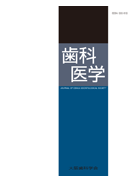Volume 63, Issue 1
Displaying 1-25 of 25 articles from this issue
- |<
- <
- 1
- >
- >|
-
Article type: Article
2000 Volume 63 Issue 1 Pages 1-14
Published: March 25, 2000
Released on J-STAGE: April 17, 2017
Download PDF (7324K) -
Article type: Article
2000 Volume 63 Issue 1 Pages 15-22
Published: March 25, 2000
Released on J-STAGE: April 17, 2017
Download PDF (1563K) -
Article type: Article
2000 Volume 63 Issue 1 Pages 23-32
Published: March 25, 2000
Released on J-STAGE: April 17, 2017
Download PDF (1116K) -
Article type: Article
2000 Volume 63 Issue 1 Pages 33-37
Published: March 25, 2000
Released on J-STAGE: April 17, 2017
Download PDF (978K) -
Article type: Article
2000 Volume 63 Issue 1 Pages 38-52
Published: March 25, 2000
Released on J-STAGE: April 17, 2017
Download PDF (6061K)
-
Article type: Article
2000 Volume 63 Issue 1 Pages 55-63
Published: March 25, 2000
Released on J-STAGE: April 17, 2017
Download PDF (926K) -
Article type: Article
2000 Volume 63 Issue 1 Pages 64-71
Published: March 25, 2000
Released on J-STAGE: April 17, 2017
Download PDF (955K)
-
Article type: Article
2000 Volume 63 Issue 1 Pages 72-73
Published: March 25, 2000
Released on J-STAGE: April 17, 2017
Download PDF (319K) -
Article type: Article
2000 Volume 63 Issue 1 Pages 73-74
Published: March 25, 2000
Released on J-STAGE: April 17, 2017
Download PDF (316K) -
Article type: Article
2000 Volume 63 Issue 1 Pages 74-75
Published: March 25, 2000
Released on J-STAGE: April 17, 2017
Download PDF (311K) -
Article type: Article
2000 Volume 63 Issue 1 Pages 75-76
Published: March 25, 2000
Released on J-STAGE: April 17, 2017
Download PDF (306K) -
Article type: Article
2000 Volume 63 Issue 1 Pages 76-77
Published: March 25, 2000
Released on J-STAGE: April 17, 2017
Download PDF (300K) -
Article type: Article
2000 Volume 63 Issue 1 Pages 78-79
Published: March 25, 2000
Released on J-STAGE: April 17, 2017
Download PDF (323K) -
Article type: Article
2000 Volume 63 Issue 1 Pages 79-80
Published: March 25, 2000
Released on J-STAGE: April 17, 2017
Download PDF (296K) -
Article type: Article
2000 Volume 63 Issue 1 Pages 80-81
Published: March 25, 2000
Released on J-STAGE: April 17, 2017
Download PDF (297K) -
Article type: Article
2000 Volume 63 Issue 1 Pages 81-82
Published: March 25, 2000
Released on J-STAGE: April 17, 2017
Download PDF (307K) -
Article type: Article
2000 Volume 63 Issue 1 Pages 82-83
Published: March 25, 2000
Released on J-STAGE: April 17, 2017
Download PDF (294K) -
Article type: Article
2000 Volume 63 Issue 1 Pages 83-84
Published: March 25, 2000
Released on J-STAGE: April 17, 2017
Download PDF (293K) -
Article type: Article
2000 Volume 63 Issue 1 Pages 84-85
Published: March 25, 2000
Released on J-STAGE: April 17, 2017
Download PDF (298K) -
Article type: Article
2000 Volume 63 Issue 1 Pages 86-
Published: March 25, 2000
Released on J-STAGE: April 17, 2017
Download PDF (189K) -
Article type: Article
2000 Volume 63 Issue 1 Pages 87-
Published: March 25, 2000
Released on J-STAGE: April 17, 2017
Download PDF (177K) -
Article type: Article
2000 Volume 63 Issue 1 Pages 88-89
Published: March 25, 2000
Released on J-STAGE: April 17, 2017
Download PDF (280K) -
Article type: Article
2000 Volume 63 Issue 1 Pages 89-
Published: March 25, 2000
Released on J-STAGE: April 17, 2017
Download PDF (165K) -
Article type: Article
2000 Volume 63 Issue 1 Pages 89-90
Published: March 25, 2000
Released on J-STAGE: April 17, 2017
Download PDF (285K) -
Article type: Article
2000 Volume 63 Issue 1 Pages 91-
Published: March 25, 2000
Released on J-STAGE: April 17, 2017
Download PDF (197K)
- |<
- <
- 1
- >
- >|
